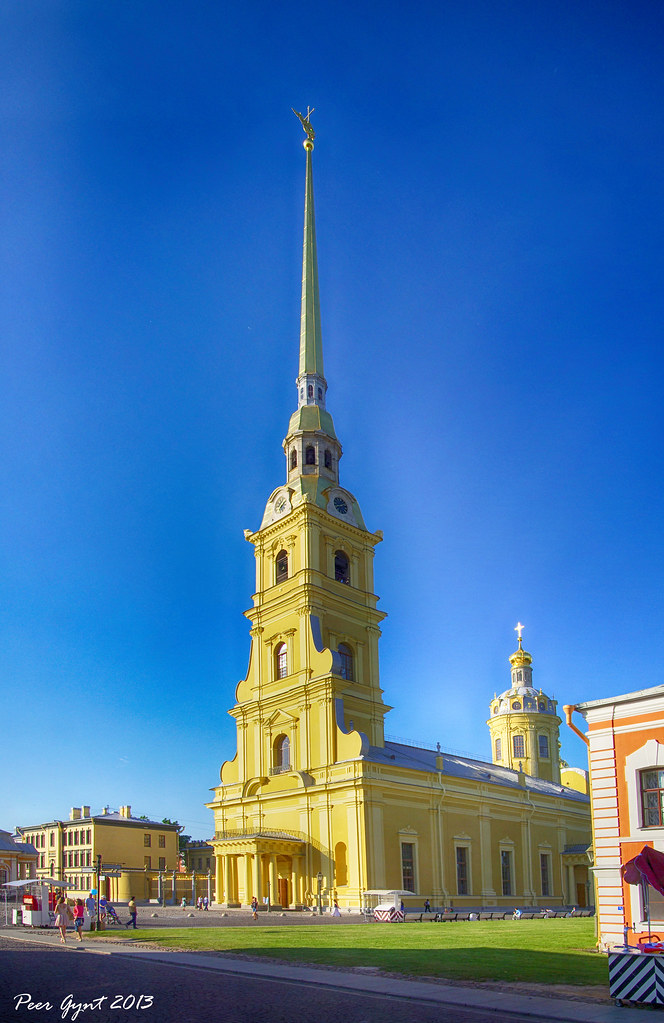
Описание: 6-image vertical panorama. Assembled in Autopano Giga software. The Peter and Paul Cathedral is a Russian Orthodox cathedral located inside the Peter and Paul Fortress in St. Petersburg, Russia. It is the first and oldest landmark in St. Petersburg, built between 1712 and 1733 on Zayachy Island along the Neva River. Both the cathedral and the fortress were originally built under Peter the Great and designed by Domenico Trezzini. The cathedral's bell tower is the world's tallest Orthodox bell tower. Since the belfry is not standalone, but an integral part of the main building, the cathedral is sometimes considered the highest Orthodox Church in the world. he cathedral is dedicated to Saints Peter and Paul, the patron saints of the fortress (Saint Peter being the patron saint of the city). The current cathedral is the second one on the site. The first, built soon after Peter's founding of the city, was consecrated by Archbishop Iov of Novgorod the Great in April 1704. The current building, the first stone church in St. Petersburg, was designed by Trezzini and built between 1712 and 1733. Its golden spire reaches a height of 404 feet and features at its top an angel holding a cross. This angel is one of the most important symbols of St. Petersburg. The cathedral's architecture also features a unique iconostasis (the screen which separates the nave of the church from the sanctuary). In the Eastern Orthodox Church the iconostasis is normally a flat wall or screen with three doors through it, the central Holy Doors used only for very solemn entrances, and the two side doors, by which the clergy and others enter and leave the sanctuary. However, at St. Peter and Paul, the iconostasis rises to form a sort of tower over the sanctuary. The cathedral was closed in 1919 and turned into a museum in 1924. It is still officially a museum; religious services, however, resumed in 2000. The cathedral houses the remains of almost all the Russian Emperors and Empresses from Peter the Great to Nicholas II and his family who were finally laid to rest in July 1998. Also buried here was Catherine the Great, Empress of Russia for 34 years. (Of the post-Petrine rulers, only Peter II and Ivan VI are not buried here. Peter II is in the Cathedral of Michael the Archangel in the Moscow Kremlin. Ivan VI was executed and buried in the fortress of Shlisselburg or Kholmogory (alleged discovery at Kholmogory in 2010 presently under forensic investigation)). The cathedral has a typical Flemish carillon, a gift of the Flemish city of Mechelen, Flanders. On September 28, 2006, 78 years after her death, Maria Feodorovna, Empress of Russia, was reinterred in the Cathedral of St Peter and Paul. Wife of Tsar Alexander III, and mother of Nicholas II, (the last Russian Tsar), Maria Feodorovna died on 13 October 1928 in exile in her native Denmark. and was buried in Roskilde Cathedral in Denmark. In 2005, the governments of Denmark and Russia agreed that the Empress's remains should be returned to Saint Petersburg in accordance with her wish to be interred next to her husband. The cathedral was the cathedral church (i.e., the seat of the bishop; the term cathedral-sobor (собор) in Russian-can mean the seat of a bishop, but it can also mean simply a large or important church) of the city until 1859 (when St Isaacs became the city's cathedral.) The current cathedral church of St. Petersburg is the Kazan Cathedral on Nevsky Prospect. Bell Tower The Bell tower (with spire) is the dominant feature of this cathedral and the fortress. It serves several functions as part of the structure: It is an architectural symbol, an important part of its shape and of the Peter and Paul Fortress. It is a part of the imperial tomb - the tombs are on the ground floor. It is a lightning rod protecting the cathedral. It is a viewing platform upon which excursions meet each hour from 12:00 till 18:00. It houses a carillon upon which concerts are periodically performed. When renovators were cleaning the angel on the spire in 1997, they found a note in a bottle left in one of the folds of the angel's gown. In the note, renovators from 1953 apologized for what they felt was rushed and shoddy work (Soviet premier Nikita Khrushchev wanted the angel refurbished for the 250th anniversary of the city that year). It is said that the renovators in 1997 left another message for future generations, but the contents of that message have not been revealed.
Tags:
Поиск и фотоизображения предоставлены компанией Flickr с помощью сервиса Flickr API согласно Правилам пользования сайтом Flick.com и его сервисами. Графические изображения являются публичными, размещёнными их авторами в свободный доступ (Public) и физически расположены на серверах Flickr. Все права на фотографии принадлежат их авторам согласно пользовательскому соглашению сервиса Flickr.com и охраняются законами, регулирующими авторские права.